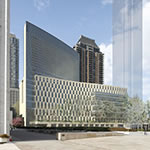When Fordham University needed a design for its new Law School and Residence Hall—the centerpiece of a 15-year master plan to build out the Lincoln Center campus in New York—it decided to open a competition. The winner was Pei Cobb Freed & Partners, with a design by partners Henry N. Cobb and Yvonne Szeto, who saw the project as an exciting challenge. “We wanted to be mindful of the three constituencies that the building would engage: its users, its neighbors, and the broader public,” says Christina Chung, an associate partner.

The Moot Court room, situated in the interior of the first floor and visible from Damrosch Park, was designed to double as an event space.
The design accommodates the unique needs of the law school and residence hall by creating a cohesive 22-floor building that expresses two very distinct identities. “The first nine floors, comprising the law school, are expressed in a gentle, undulating form with a precast checkerboard façade, while the undergraduate residence hall is clad in a lighter aluminum-and-glass curtainwall façade that rises for 12 stories above the law school,” Chung says. “The two forms meet in a way that reinforces their unity.”
Seeking LEED Silver certification at minimum, the building’s energy-efficiency measures will exceed the campus-wide goal of reducing the university’s carbon footprint by 30 percent by 2017. The tower has a pEUI (potential energy use intensity) of 41 kBtu/sf, a 58 percent reduction from the regional site average for a similar building. The main savings come from high-performance boilers, a combined-heat-and-power cogeneration system, and condensing domestic-hot-water heaters.
“Our approach to design has always had its roots in the programmatic needs of the client and in responding to the site conditions and constraints,” Chung says. “Fordham University’s new Law School and Residence Hall is very much the result of a careful study of how to meet those requirements while providing an iconic form that will also be a welcome addition to the surrounding environment.”

